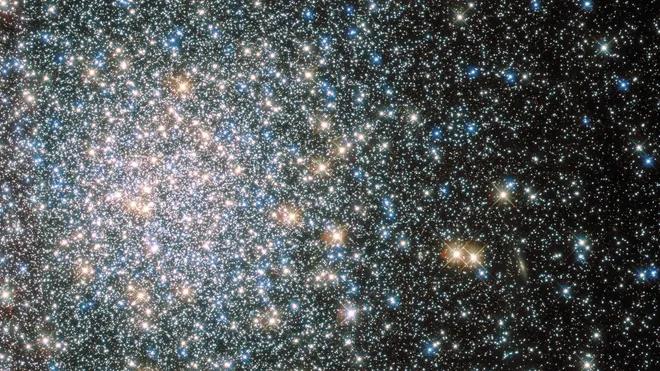
We can reach for the stars all we want, but the nearest one is 80,000 years away.
NASA Via AFP/Getty Images
The full textual contents of this web page were originally found here:
https://www.usatoday.com/story/news/nation-now/2014/05/02/space-day-distances/8618041/
This web page and all its contents were created purely for academic reasons, since the contents no longer exist on USA Today's website.

It's Space Day, but traveling the vast entity that is space would take far longer than a single day.
It's big out there! And, based on our current level of technology, here's about how long it would us take to reach:
[ Note by Daniel B. Sedory: Yes, the phrase "us take"
The moon: 1-3 days
Mars: 150-300 days
The "end" of our solar system: 40 years
The nearest star: 80,000 years
The nearest galaxy: 749,000,000 (that's 749 million) years.
The end of the known universe: 225,000,000,000,000 years (that's 225 trillion) years.
Sources: Universe Today, NASA, Phil Plait, Slate
Some notes on the above by Daniel B. Sedory:
Distance to the moon: 225,623 miles (min or perigee) and 252,088 miles (max or apogee). If it took 1 full
day (24 hrs) to travel the minimum distance that would give us an average speed of: 225,623 mi/24 hrs = 9,400.958 miles per hour. But, a spacecraft
can NOT travel by direct line-of-sight to the moon! Why? Because the moon is in constant motion around the earth. From various references online,
it appears the Apollo 11 spacecraft traveled about 240,000 miles on its way to the moon, and it took 76 hours to do so, giving us an average speed
for those 3+ days of: 240,000 mi/76 hrs = 3,157.895 miles per hour. That seems far too slow, right? But it's very important to realize that includes
all the braking it took to slow the craft down and place it into orbit around the moon. They actually attained a maximum speed of 24,791 mph
at some point after escaping from earth's gravity.
Concerning Mars: It's closest approach was 34.8 million miles in August of 2003. But just as with the moon, a spacecraft would have to travel
much farther than that in order to get to where Mars would be by the time it got there! The article above is based on the statistics for various
probes sent there and how long they took to arrive:
Mariner 4 (28 NOV 1964 to 14 JUL 1965) or: 228 days
Mariner 6 (25 FEB 1969 to 31 JUL 1969) or: 156 days
Mariner 7: only 131 days
Mariner 9 (30 MAY 1971 to 13 NOV 1971) or: 167 days
On the page, https://www.universetoday.com/14841/how-long-does-it-take-to-get-to-mars/, it states: "This is the same pattern that has
held up for more almost 50 years of Mars exploration: approximately 150-300 days." which is obviously the same statistic used by Mr. Rice.
Rice's 'stat' for the "end" of our solar system likely comes from the Voyager missions, and he could have used: 2013 - 1977 = 36 years, but for some reason he rounded it up to 40 years. (See: https://voyager.jpl.nasa.gov/news/details.php?article_id=106 Unfortunately, NASA continues, as their diagram on this page shows, to present the evolutionary THEORY of the "Oort Cloud" as if it were fact.)
Alpha Centauri is the nearest star to earth at about 4.3 light-years away. Using a distance of 25 trillion miles and Rice's stat of 80,000 years would come out to an average speed of: 25,000,000,000,000 miles/80,000 years or 312,500,000 miles per year. Using a value of 8,765.82 hours in a tropical year, that would give us: 35,649.8 miles per hour. I don't have any idea how many miles a spacecraft would have to actually travel to get there; and it's almost certain that it would disintegrate before doing so, but that's certainly an obtainable speed.
Jumping to Rice's last item: What average speed did he use for getting to the edge of the universe? Well, how far is 46.6 billion light-years? That would be about: 2.7394394239 x 1023 miles divided by his 225,000,000,000,000 years which works out to about 1,217,528,632.8444 miles per year, and dividing that by 8,765.82 hours gives us: 138,895 miles per hour! Right away, I can't help but wonder how he arrived at that speed? And that doesn't appear to have taken into account the apparent expansion of space in any way! The current estimate for the expansion of space is: 72 Km/sec/megaparsec = 44.7387 miles/sec/megaparsec, or 161,059 miles per hour/megaparsec; which is faster than what it seems is the average speed Rice used; at least when you get far enough away from the earth and even beyond our Solar system. Someone really needs to provide a reputible source and perhaps a different time for this; if they even believe it's theoretically possible! COULD THIS BE WHY this article's contents was pulled from USA TODAY??
Note: The speed of light is about: 186,282 miles per second and multiplying that by 3600 gives us 670,615,200 miles per hour. However, I've seen a more accurate value of 670,616,624.910 miles per hour for the speed of light; obviously using more than 6 digits to begin with.